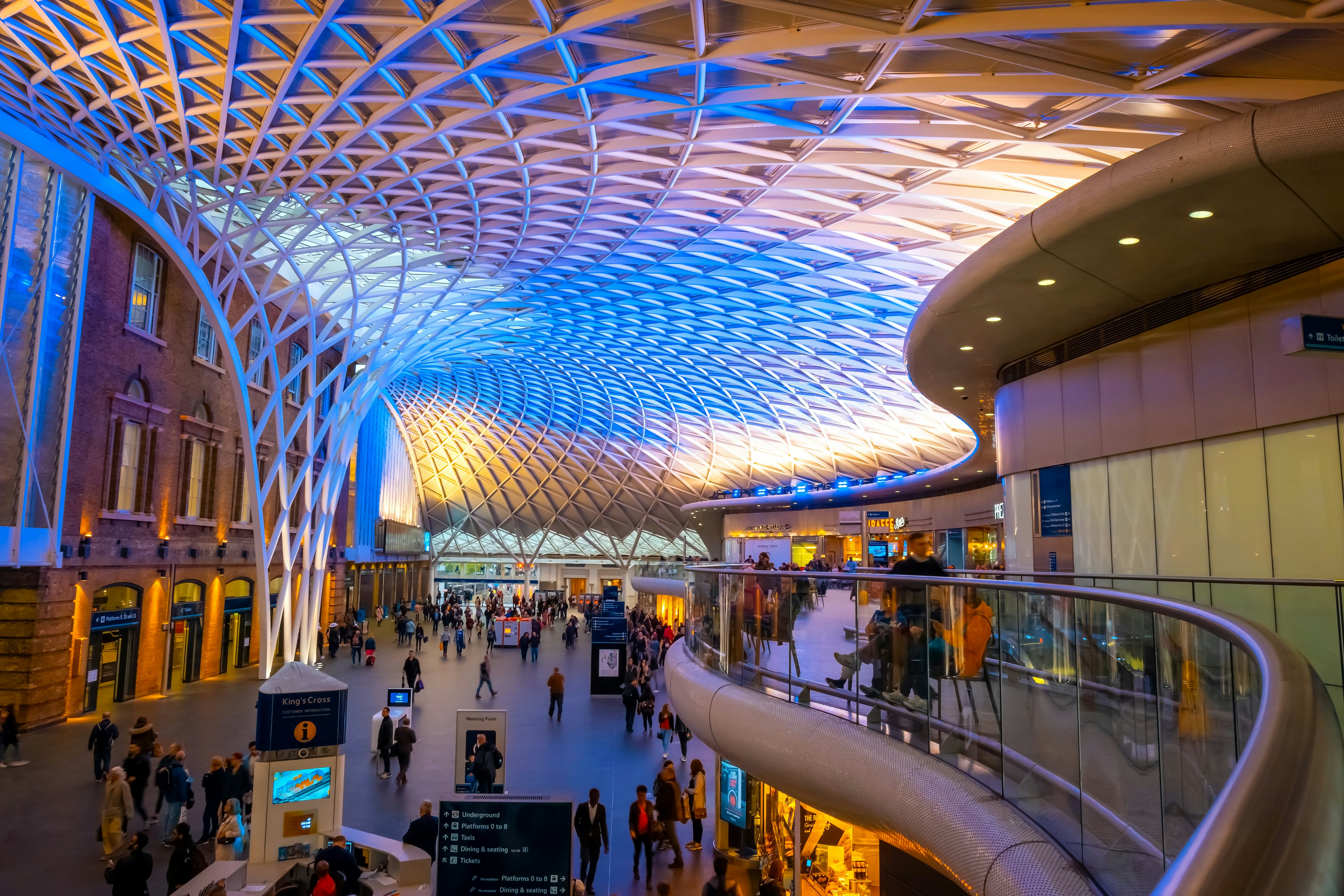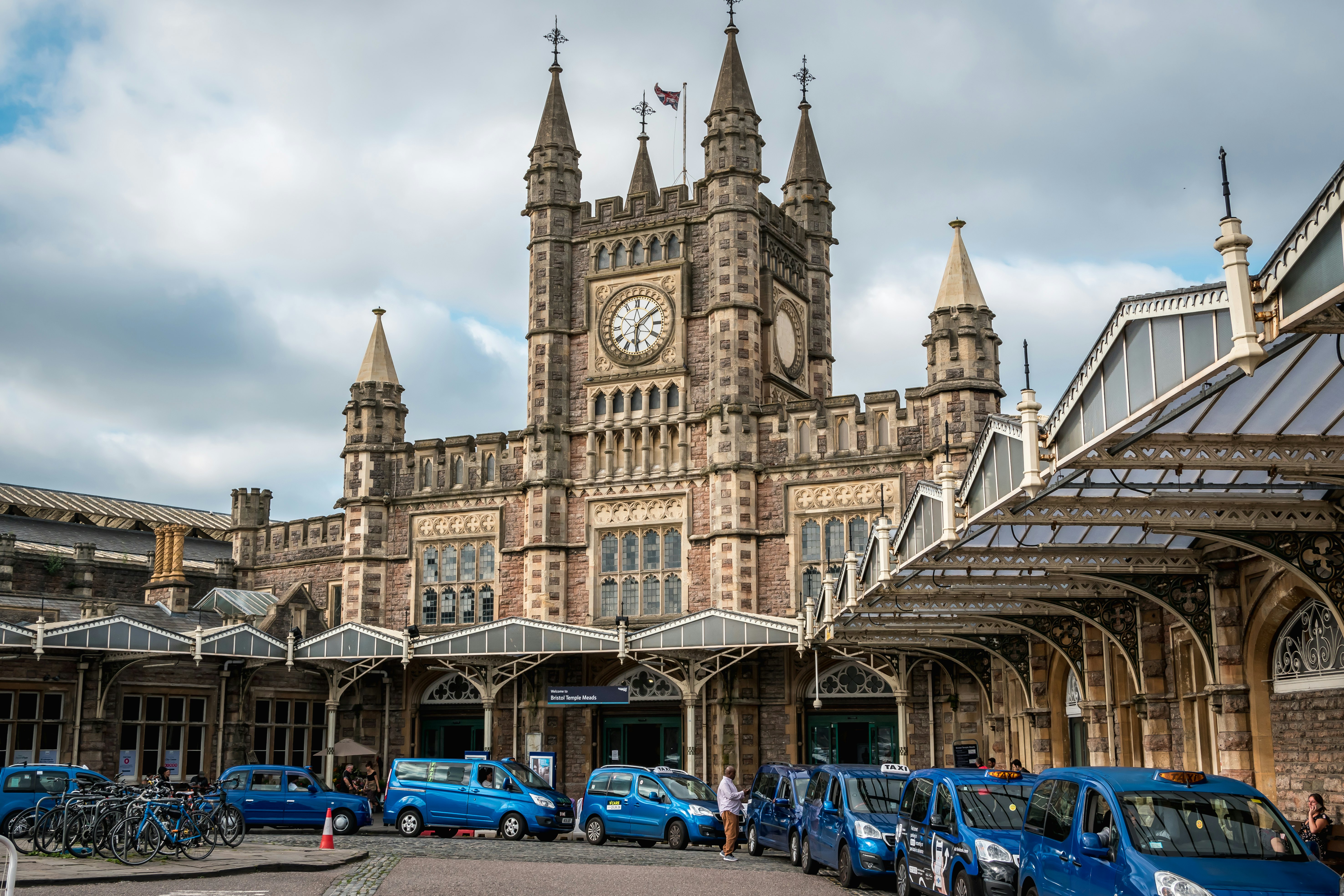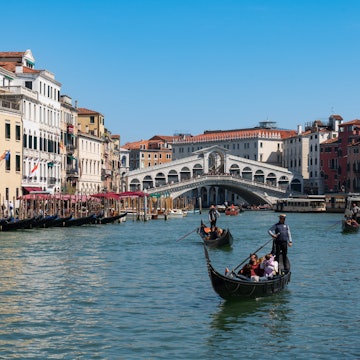

A train at a platform in York Station. Jack Cousin/Shutterstock
In 1825, the world’s first steam-powered passenger train ran from Stockton to Darlington. Two centuries later, some of England’s stations remain not just gateways, but milestones in the history of travel, and destinations in themselves.
“They are our gates to the glorious and the unknown,” English writer and rail enthusiast, EM Forster, once said of London’s train stations. “Through them we pass out into adventure and sunshine, to them, alas! we return.” Perhaps that’s why I’ve learned to arrive early for trains in England – not out of anxiety about missing them, but to marvel at the stations. The soaring roofs and ornate facades hark back to Victorian ambition, which makes waiting for a train and exploring the station a vital – and extremely enjoyable – part of the journey.
Here’s a guide to England’s most beautiful stations, and what to do when you step outside their doors.

1. St Pancras International, London
Few stations are as dramatic as London's St Pancras, with its Gothic Revival facade of red brick and spires designed by George Gilbert Scott in the 1860s. Opened in 1868 to link London with northern cities, it is now the UK’s rail gateway to Europe.
Beneath its soaring iron-and-glass train shed, it doubles as a destination. Searcys St Pancras, Europe’s longest champagne bar, stretches along the concourse with trackside views. Paul Day’s bronze the Meeting Place sculpture greets travelers under the clock, while a statue of poet Sir John Betjeman honors the man who saved the station from demolition. Booking Office 1869, housed in the former ticket hall of the adjoining St Pancras Renaissance Hotel, serves meals with a daily ritual: a free drink is offered daily at 5:05pm.
Detour: Across the road, a different kind of treasure awaits at the British Library, where free exhibitions showcase everything from Magna Carta to handwritten Beatles lyrics. A short stroll away, Coal Drops Yard, a reinvented Victorian railway goods yard full of trendy restaurants, shops and cafes, is ideal to explore if your train is later.

2. King’s Cross Station, London
King’s Cross – right next door to St Pancras International – is now synonymous with Platform 9¾, where Harry Potter fans line up for a photo. Yet the real magic lies in the station. Opened in 1852 as the London terminus of the Great Northern Railway, it was designed by Lewis Cubitt to be simple, functional and strikingly modern. Built of yellow stock brick, its twin train sheds made it the largest station in Britain, a true “gateway to the north”.
The 2012 concourse brought light and space to a once congested station, blending heritage with modern design. Inside, travelers can pause at the Parcel Yard, a pub in former railway offices, or explore the King’s Cross Story Exhibition, chronicling the area’s layered history.
Detour: Just outside, a different kind of journey awaits in Granary Square, the heart of the King’s Cross redevelopment. Fountains dance in the plaza, cafes spill onto terraces, and there are plenty of places to pause for people watching. Follow the Regent’s Canal for a scenic walk, and stop at the floating Word on the Water book barge for a literary surprise.

3. Huddersfield Station, West Yorkshire
Described by Sir John Betjeman, poet and writer, as “the most splendid station facade in England”, Huddersfield’s frontage resembles a Roman temple transplanted into Yorkshire. Completed in 1850 and designed by architect James Pigott Pritchett, the neoclassical facade, with its six-by-two Corinthian portico, dominates St George’s Square. Period details mingle with modern amenities inside but the exterior remains the real showstopper.
Huddersfield also does something most towns don’t: it puts a great pub right inside the station. The Head of Steam serves Yorkshire ales in surroundings full of character. The station has some equally beautiful neighbors, including the Grade II-listed Britannia Buildings, designed by Sir William Tite.
Detour: Just a short walk away, the Tolson Memorial Museum houses exhibits ranging from Roman artefacts to textile collections. Outdoor enthusiasts can explore Castle Hill and Victoria Tower, with panoramic views, or stroll through Greenhead Park, a Victorian park with lakes, gardens, and a café.

4. Liverpool Lime Street, Merseyside
One of Britain’s oldest and most storied railway termini, Liverpool Lime Street opened in 1836, at the height of the country’s railway boom. The modest station soon expanded to match the city’s growing industrial ambitions. The first major addition came in 1849, with the addition of a grand château-like building that was once the North Western Hotel. Designed by celebrated architect Alfred Waterhouse in a Renaissance Revival style, its ornate stone facade still greets passengers as the Radisson Red Hotel.
But it is the expansive iron-and-glass train shed behind this frontage that gives Lime Street its true drama. The initial idea was to model the roof on Euston’s ridge design, but a Dublin ironworks proposed something far bolder: a single sweeping curved roof. After rigorous tests and some fine-tuning, it was completed in 1849, forming the largest iron roof ever built and the first of its kind to cover a railway station.
Detour: Lime Street sits right at the heart of Liverpool’s cultural quarter. Step outside and you’re within minutes of the Walker Art Gallery, with masterpieces spanning centuries, or the Empire Theatre, where the Beatles once performed.

5. Bristol Temple Meads, Bristol
Designed by civil engineer Isambard Kingdom Brunel and opened in 1840, Bristol Temple Meads Station stands as a testament to Victorian engineering. The name reflects the station’s location on land owned by the Knights Templar in the 12th and 13th centuries.
The original mock-Tudor design, reminiscent of London’s Paddington Station, featured a simple arrival and departure platform. Over the years, the station underwent several expansions to accommodate increasing passenger numbers, including extensions in the 1870s and 1930s. Today, the station blends historic architecture with modern amenities, including a range of shops and cafes.
Detour: A short walk from the station, the harborside is a vibrant area filled with waterside bars, historic warehouses and street art, including original works by Banksy. The twice-a-week Temple Quay market showcases Bristol's rich and diverse street food culture.

6. Durham Station, County Durham
Few arrivals are as stirring as Durham’s. The railway line approaches the station via the eleven-arched Durham Viaduct, a major local landmark, and the building, perched high above the River Wear, offers one of England’s most dramatic first views: the medieval cathedral and castle rising together on a rocky peninsula.
Built in 1857, the station itself is modest: an old stone building that now serves as the ticket hall and main concourse. However, it is the framing of Durham’s centuries-old skyline that the train journey provides that makes it unforgettable.
Detour: The loop path along the River Wear offers ever-changing angles of the stunning Durham Cathedral, reflected in the water, and a quieter moment to appreciate why Durham has UNESCO World Heritage status.

7. York Station, North Yorkshire
When it opened in 1877, York railway station was the largest in the world, a grand feat of Victorian engineering by the North Eastern Railway. Designed on a sweeping curve, its vast train shed was supported by three rows of cast-iron columns and graceful wrought-iron arches, with brick walls enclosing the monumental space. The complex included 13 platforms, elegant buildings, and an adjoining hotel.
Even today, standing on the platforms beneath its sweeping curves, you can feel the grandeur of Britain’s golden age of rail. York is a city steeped in railway history, and the station – with its honey-colored brickwork and repeating arches – remains at its heart, with plaques marking wartime bombings and royal visits.
Detour: Right behind the station lies the National Railway Museum, free to enter and home to legendary locomotives like Mallard, the world’s fastest steam engine.

8. Great Malvern Station, Worcestershire
Great Malvern Station, opened by the Worcester and Hereford Railway in 1860 and completed in its present form 2 years later by architect Edmund Wallace Elmslie, is a place where time seems to slow. The station’s red-brick and rubble-stone buildings are full of Victorian charm, from the slate roofs topped with cast-iron cresting and wrought-iron finials to the platform canopies supported by cast-iron columns adorned with an astonishing variety of wrought-iron leaves and flowers. Stained glass, decorative tiling, and an array of graceful chimneys add elegance.
The station is nestled at the foot of the Malvern Hills, the beautiful landscape that inspired composer Edward Elgar and writer JRR Tolkien. It stands tall as a reminder of how the railway helped spa towns like Malvern to flourish.
Detour: Step into town and follow the Malvern Trail, which links historic springs and fountains where people once came to “take the waters”. Or check the listings at Malvern Theatres, a cultural institution that always has a lively program.

9. Carnforth Station, Lancashire
Once a quiet Lancashire village, Carnforth was transformed by the coming of the railways into a thriving junction town. The Lancaster and Carlisle Railway opened its line here in 1846, followed by the Ulverston and Lancaster Railway in 1857, firmly establishing Carnforth as a key stop on the northern network. During the 1870s, the station was enlarged to designs by local architects Paley and Austin, its new layout and architecture reflecting the growing ambition and significance of rail travel in the region.
Yet today, Carnforth is celebrated less for its scale than for its sentiment. Immortalized in David Lean’s 1945 classic Brief Encounter, its concourse clock and lovingly restored 1940s refreshment room evoke a deep sense of nostalgia and spotlight the romance of the railways.
Detour: After tea in the Brief Encounter Refreshment Room, explore the station’s Heritage Centre, which tells the story of Carnforth’s wartime role and its cinematic fame.
















